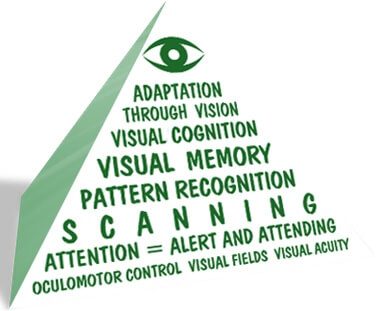
Visual-Perceptual Delays
It’s no surprise that visual-perceptual delays are common in children with Sensory Integration Dysfunction. Visual-perceptual skill refers to a person’s ability to interpret, analyze, and give meaning to what he or she sees. Normally more than 70 percent of classroom “underachievers” have problems processing visual information, even if they have 20/20 eyesight.

Visual discrimination allows the child to identify distinct features of objects such as color, shape, size, and orientation. This skill enables her or him to match and categorize objects. As she or he grows, she or he can perceive the difference between a triangle and a circle, or B and b. The child with visual discrimination problems may have trouble recognizing faces or noticing the difference between a rectangle and a square.
Visual attention allows a child to pay attention to what he or she is doing while blocking out extraneous stimuli. A child who is easily distracted has trouble sustaining visual attention. When reading, a child may feel compelled to look at any visual stimuli around him. Visually scanning around all the words on the page rather than just focusing on the words that he should read. Some kids have trouble shifting their visual attention and learning the information that they are looking at. Some of them may not notice when something else is happening around them. A visually hyporesponsive child may have problems in noticing a visual stimulus or sustaining visual interest and feel tired after a short time. For those children who are not paying visual attention have missed out those vital developmental opportunities. This is because they are not listening and digesting the information around them.
Visual memory allows a child to remember things he or she has seen. This is an essential skill for imitating new gestures and movements, sequencing writing and spelling tasks, recognizing words and people, and more. With a poor visual memory, he or she may have the excellent memory for life experiences rather than factual information and may have difficulty in relating new visual information to what he or she already knows.

Figure-ground allows a child to differentiate between foreground and background. This is essential to keep the child’s attention to the important visual stimuli and does not get distracted by the surrounding. For examples, this skill enables him to find his favorite dump truck in a box full of toys and keep his eyes on the teacher in a busy classroom. The child with figure-ground difficulty may have trouble reading because he cannot differentiate some specific words on a page when he or she is reading.
Visual closure allows a child to use visual clues to recognize objects without seeing the entire image. For instants, this skill enables ones to find a lunchbox even it’s partially hidden behind a milk carton, this skill also enable ones to recognize a complete word if he has only seen a part of that word (proficient readers do not have to look at every letter).
Form constancy allows a child to perceive things as the same regardless of environment, position, size, and other details. For examples, ones will know what is spoon after being taught regardless of its position of the spoon (upside down, turned sideways) and other details such as material (a silver tablespoon or a plastic toy spoon). In school, ones learn that the letter S is an S whether it’s handwritten or typed, in print or cursive, or sideways.
Laterality, directionality, and spatial vision:
Laterality allows a child to differentiate between right and left sides of his own body. Directionality allows the child to perceive the right and the left side of external objects. Both are essential to spatial vision, which tells the child on how an object is positioned in space. For example, with that skill, ones know how to differentiate between the lowercase b which has a line on the left side and the d has a line on the right side. A child with a poor spatial vision may have difficulty in playing with toys, learning to climb stairs and catch a ball (both require depth perception), and developing many self-care tasks. Ones may have persistent letter reversals (beyond age eight), be confused about the letter or number sequences, and have trouble understanding directional words such as up, down, in, out, under, and over, and have poor topographical orientation and lost easily.
A child also needs to develop her visual-motor integration skills. His or her eyes and body must work together to accomplish many developmental tasks, from stringing beads to catching a ball. The visual-motor integration skills are referred to as eye-hand coordination skills. The visual-motor integration is the term used for the interaction of motor skills, Visual perceptual skills, and visual-perceptual skills.
We understand that you might have a number of questions, especially if this is the first time you have experience any eye problems.
Feel free to call our office- Sun Time Vision Specialist Centre Kuala Lumpur at 03-2110 3967 and our Behavioral and Developmental optometrists will be ready to help your vision problem.
Reference:
- Biel, L., & Peske, N. K. (2005). Raising a sensory smart child: the definitive handbook for helping your child with sensory integration issues. New York: Penguin Books.)


